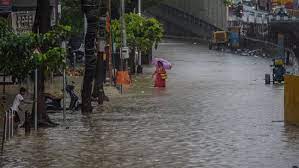Dr. Seema Javed
 It is not very long when we saw extremely severe cyclone Tauktae wreaking havoc in Mumbai and claiming several lives. And now, it is the Mumbai Monsoon that has wrenched the maximum city on the very first day of its arrival.
It is not very long when we saw extremely severe cyclone Tauktae wreaking havoc in Mumbai and claiming several lives. And now, it is the Mumbai Monsoon that has wrenched the maximum city on the very first day of its arrival.
Santa Cruz Observatory recorded a whopping 231 mm of rain in a span of 24 hours from 8:30 am on Wednesday. Although, it is not something unusual for Mumbai as the city has been witnessing several spells of 3-digit rainfall every year during the Monsoon season. According to weathermen, the ongoing weather is a very typical pattern of Mumbai Monsoon. However, it is now the coming days to watch out for as meteorologists warn of flood-like conditions in Mumbai.
GP Sharma, ex-AVM Meteorology, Indian Air Force and President-Meteorology and Climate Change at Skymet Weather said, “A cyclonic circulation is marked over East-central and adjoining North Arabian Sea, along with an off-shore trough running off the West Coast. As a result, strong westerly winds were reaching Mumbai, resulting in extremely heavy showers.”
Rains are likely to take a brief break on June 11. But with another weather system coming up in Bay of Bengal, heavy to very heavy rains will return June 12 onwards. “A cyclonic circulation is marked over east-central and adjoining Northeast Bay of Bengal. The weather system is expected to organize and deepen into a low-pressure area by tonight. In the subsequent 24 hours, it is likely to intensify further to a well-marked low or depression over the Head Bay of Bengal. Monsoon systems prevailing on either side of the coast tend to interact with each other, bringing widespread rainfall. This is known as ‘dumble effect’. We can expect active to vigorous Monsoon conditions from June 11 to June 15. The western arm of the monsoon over the Arabian Sea will strengthen to lash the entire West Coast (Kerala, Karnataka, Goa, Konkan) with heavy to very heavy rains between 09th and 16th June. Mumbai will directly come in the firing range of Monsoon. The severe flooding situation is quite likely over and around Mumbai between June 13-15,” added Sharma.

How climate change is influencing the weather
We saw Cyclone Tauktae intensifying manifolds on account of above normal sea surface temperatures across Arabian Sea. In fact, by the time it was passing Mumbai, it had already intensified into an extremely severe cyclone, just one level down from being a super cyclone. Atmospheric conditions were so ripe that had there been more sea travel left ahead, it would have become a super cyclone too.
Although we do not see a similar situation right now, but global warming is surely playing a major part this time too. As per the weather experts, there is plenty of moisture available in the atmosphere with the onset of Monsoon. And, with sea surface temperatures still very warm, it will continue to fuel intensification system forming in Indian basins.
Dr Roxy Mathew Koll, climate scientist at the Indian Institute of Tropical Meteorology, Punestates, “Ocean and atmospheric conditions are still very much conducive for weather systems to intensify. Though there has been some sea surface cooling post the cyclones, the ocean continues to be warm with temperatures hovering around 30°C and over. These warm sea surface temperatures and low vertical wind shear are conducive for a low-pressure system to form and intensify over the north Bay of Bengal, but not a cyclonic storm. Arabian Sea is also warm and moist, so the monsoon winds may carry more moisture as it gets pulled inland and strengthens in response to the low-pressure system in the Bay. Our research shows that there is an increasing trend in these kinds of events resulting in heavy rains over the west coast and central India.”
Threats to Coastal Cities
As climate change triggered tropical cyclones are on the rise in coastal India, the unplanned development adds to the vulnerability of these cities. For instance, flooding in India over the last decade caused $3 billion of economic damage – about 10% of global economic losses from flooding. Cyclone Amphan in 2020 affected 13 million people and caused over $13 billion in damage after it made landfall in West Bengal.
Multiple studies claim that India’s largest coastal cities, like Mumbai and Kolkata, are facing the severest threats from climate-induced flooding. Floods in Mumbai and Kolkata are attributed to the impact of climate shifts, urbanization, sea-level rise and other regional factors.
Also read :IN a first: Cryptocurrency, a legal tender in El Salvador
Also read : Every region on Earth can replace fossil fuels with renewable energy to keep warming below 1.5ºC
According to a report by the Ministry of Earth Sciences (MoES), Government of India, Assessment of Climate Change over the Indian region, Mumbai region is highly vulnerable to climate change due to sea-level rise, storm surge and extreme precipitation. During the last 20 years, Mumbai has already seen massive flood events in 2005, 2014, 2017.
Mumbai floods 2005 saw heavy downpour to the tune of 994 mm of rain in just 24 hours and 684 mm in only 12 hours. Rains triggered massive flooding of the Mithi river. The impact was further amplified by the high tide and inadequate drainage and sewage resulting in massive flooding.
 Jubilee Post News & Views
Jubilee Post News & Views





